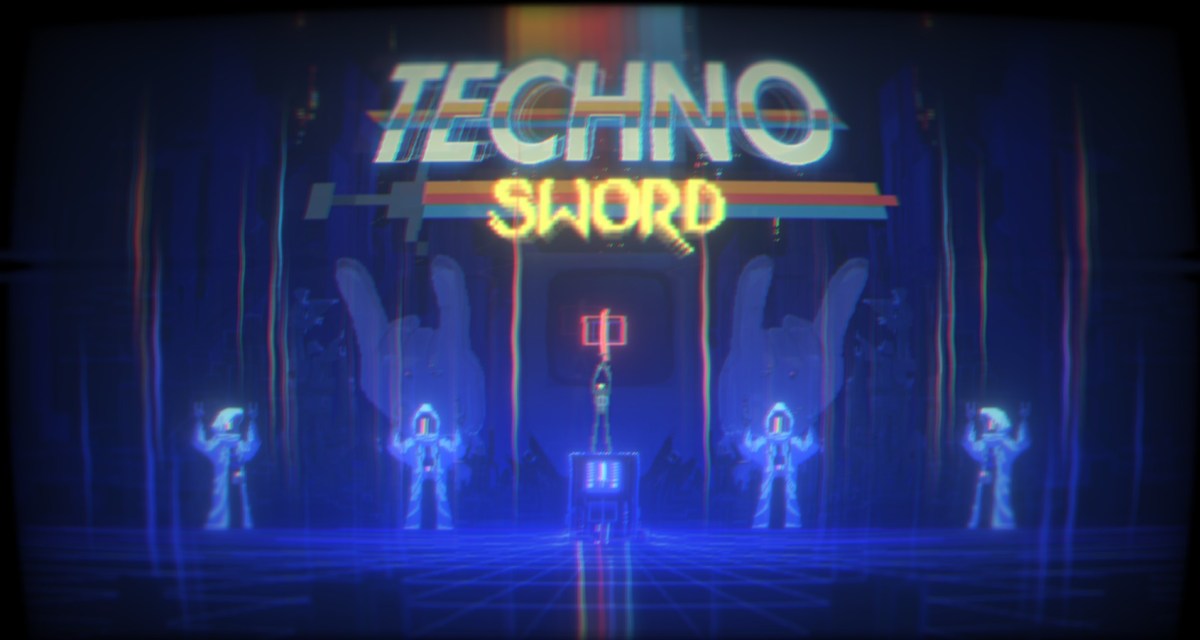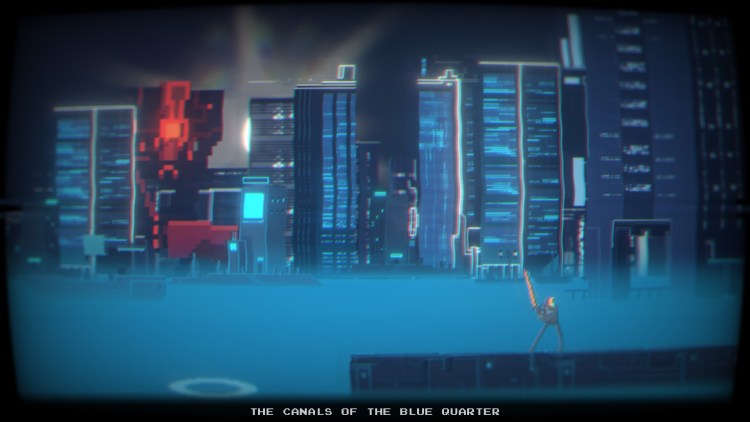It admittedly took me a while to start an actual game of Narita Boy. As the names of the developer and publisher Team17 flash by, a pulsing synth begins in the background. Narita Boy’s title screen pronounces itself with an impassioned shout, and the game’s theme kicks in. It’s one of the catchiest title screen bops that my ears have had the pleasure of hearing. It tells the story of the titular Narita Boy with an auto-tuned voice and musical accompaniment filled with energy and hope.
After about 10 minutes of simply vibing to the music, I decided to finally start the game. The genesis of the story takes inspiration from Tron. You are a non-descript boy with a video game addiction. After taking a scolding from your mom for the umpteenth time, your computer screen flashes. Without warning, you’re sucked into a realm beyond reality called the Digital Kingdom. You are Narita Boy, the savior of this mysterious new dimension.
You learn that the Creator, the man responsible for the Digital Kingdom and all of its code, has gone missing. HIM, an evil entity hell-bent on controlling the Digital Kingdom, has returned after years in exile. The Creator, well, created a set of memories as a safeguard against HIM. Somehow, with the help of his Stallions, HIM has destroyed these memories. As Narita Boy, you must restore the memories and use the power to banish HIM once and for all.
I would be remiss if I did not mention that the music never drops off. I pray that Narita Boy’s soundtrack gets added to Spotify. But that’s just a piece of the breathtaking world in the Digital Kingdom. Narita Boy is one of the most polished and consistently entertaining Metroidvanias in recent years. The visuals are stunning, the combat stays fresh despite 2D limitations, and it only takes about nine hours to beat.
Varied aesthetic
Given its side-scrolling nature and short run time, it’s fair to think that Narita Boy wouldn’t have much to offer in the way of world design. That assessment could not be further from the truth. As with the music, there were times where I would have to pause in awe. The backdrops felt alive. There was organic movement, whether it be flowing water or birds flying through the sky. Of course, Narita Boy benefits from its several settings, each vastly different from the next.
You start off in the Temple of the Techno-Sword before moving on to three color-coded kingdoms. Each house corresponds with a color of the Trichroma, the central line of code for the Digital Kingdom. Each house presents a different sort of environment. The Yellow House is a plaid desert, home to fearsome knights dedicated to its protection. The Blue House is themed around water, with bathhouses and constant rainfall. The Red House, where HIM originated, feels post-apocalyptic. Its main feature is a ruined temple with sprawling murals foretelling Narita Boy’s ascension. Then there’s The Capital, the final stage of the game. Here, the upper echelon from each house mingle. It’s a sprawling metropolis with bustling street life that you must weave through.
Narita Boy even plays with the camera, panning out to grandly reveal statues or gargantuan cathedrals. It imparts the sense of grandeur and reverence that such structures command. All of this is hidden behind a fuzzy CRT television filter. This can be turned off, but do yourself a favor and leave it alone.
Scaling enemies
As Narita Boy, you can wield the Techno-Sword. It’s the only weapon capable of eliminating Stallions. To do so, you can employ a standard slash attack. The slash can charge into a more powerful swing. The Techno-Sword doubles as a shotgun, though there’s a limit on ammo. These do recharge over time. If you’ve got a full clip, it can be transformed into the Ultra Beam: Narita Boy’s most powerful attack.
As the game progresses, you’ll add skills like dash and shoulder bash to your arsenal. Of course, all this would be useless without the requisite cannon fodder. Narita Boy boasts a diverse menagerie of enemies. In fact, I find it hard to recall the name of each type of foe I encountered. That’s not a bad thing, as a wide enemy pool helps to keep combat from feeling stale.
What I enjoyed most about fighting in Narita Boy, though, is that each enemy felt like a building block towards the next. The Zombie, the drone of the Stallion army, helps you learn the basics of combat. Then there’s the Jumper, the athletic cousin that makes dodging a necessity. Each time Narita Boy gains a new attack, there’s a corresponding set of Stallions. Each boss is a culmination of everything you’ve learned to that point, stretching your skills.
Narita Boy is tough. There are areas with gauntlets of Stallions that are hard to overcome on the first playthrough. Bosses took more than one attempt to defeat. The checkpoint system is forgiving, thankfully, with frequent autosaves. Narita Boy isn’t limited by a system of “lives,” and you’re never too far back from the section you died in. It’s refreshing to learn a boss’ attack patterns and beating them feels genuinely rewarding as you find creative ways to employ Narita Boy’s attacks and movement.
Customization lacking
The only thing holding Narita Boy back is its lack of customization. For a PC title, there’s no way to set personal keybindings. Instead, three presets are on offer. The same can be said if you choose to use a controller or gamepad.
Additionally, Narita Boy does not support mouse input. You navigate the menus with the arrow keys or WASD. Each attack is bound to a different letter on the keyboard, as opposed to a click. For me, I found it challenging to remember exactly what each key did, and they’re all clustered together. This added to the confusion.
Don’t let this dissuade you from checking Narita Boy out, a resounding debut for Studio Koba. If you’re tired of Metroidvanias, Narita Boy breathes new life into the genre. From its unique setting to the engaging combat, there are few better ways to spend several hours.










Published: Mar 29, 2021 08:00 am